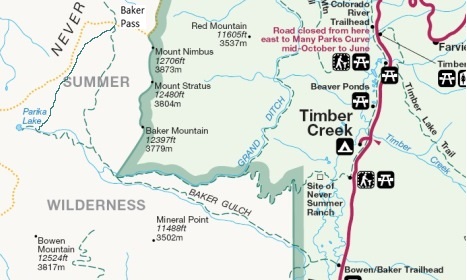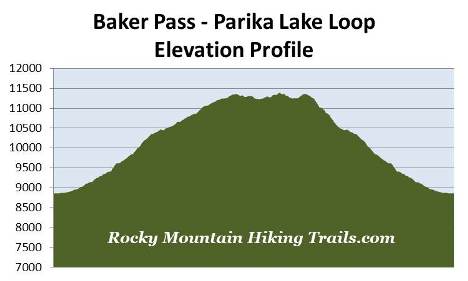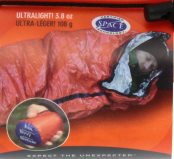
Baker Pass - Parika Lake Loop
| Trail Features: | Outstanding Panoramic Views, Alpine Lake | 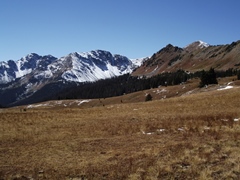 |
|||
| Trail Location: | Bowen/Baker Trailhead | ||||
| Roundtrip Length: | 13.5 Miles | ||||
| Trailhead Elevation: | 8860 Feet | ||||
| Total Elevation Gain: | 2625 Feet | ||||
| Avg. Elev Gain / Mile: | 389 Feet | ||||
| Highest Elevation: | 11,390 Feet | ||||
| Trail Difficulty Rating: | 18.75 (strenuous) | ||||
| Parking Lot Latitude | 40.35486 | ||||
| Parking Lot Longitude | -105.85767 | ||||
Trail Description:
The Baker Pass-Parika Lake Loop hike begins from the Bowen/Baker Trailhead, located 6.1 miles north of the Grand Lake Entrance. Although the hike starts in Rocky Mountain National Park, most of the route travels through the Never Summer Wilderness of the Arapaho National Forest.
The hike begins by crossing over the Colorado River, and then proceeds to travel along a gravel road across the Kawuneeche Valley. This valley is prime habitat for elk and moose, especially near the river and surrounding wetlands where sightings are fairly common. Both the Ute and Arapaho Indians used the Kawuneeche Valley as a summer hunting ground.
After walking about a quarter-mile hikers will reach the western edge of the meadow. Just past the treeline you'll notice a sign that reads "Baker Gulch / Bowen Gulch Trailhead to the left". Simply continue along the gravel road at this point. At just over one-third of a mile you'll reach a gate blocking the road. The Bowen Gulch Trail continues past the gate, while the Baker Gulch Trail branches off to the right. Hikers should turn right at this junction to continue towards Baker Pass.
At roughly three-quarters of a mile you'll exit Rocky Mountain National Park and enter the Never Summer Wilderness of the Arapaho National Forest. At the boundary is a kiosk to register your party, which is always a good idea in case you were to ever become lost or injured.
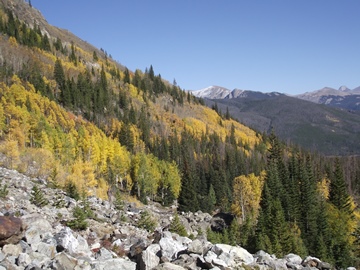 The Never Summer Wilderness receives its name as a result of it being located within the Never Summer Mountains. The Arapaho Indians called these mountains "Ni-chebe-chii", which translates into “Never No Summer”. Wishing to avoid the use of a double negative, the U.S. Department of the Interior's Board on Geographic Names settled on Never Summer Mountains. Prior to its official naming, the mountains were known as the Rabbit Ear Range.
The Never Summer Wilderness receives its name as a result of it being located within the Never Summer Mountains. The Arapaho Indians called these mountains "Ni-chebe-chii", which translates into “Never No Summer”. Wishing to avoid the use of a double negative, the U.S. Department of the Interior's Board on Geographic Names settled on Never Summer Mountains. Prior to its official naming, the mountains were known as the Rabbit Ear Range.
During the early portions of the hike the trail travels over mostly easy to moderate terrain, while passing through a dense lodgepole pine forest. At roughly 3 miles the trail enters a fairly large boulder field where the route becomes a little more rugged. The terrain also begins to open up here, with views of Peak 12,442 almost straight ahead. Hikers will likely notice many aspens throughout this stretch. As you pass through this area you should also keep an eye out for scraps of old rusted equipment, presumably remnants from the mining era.
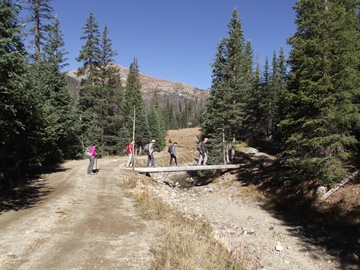 At just over 3.4 miles hikers will reach the Grand Ditch, an irrigation canal that diverts water from the Never Summer Mountains, over the Continental Divide, and into the Cache La Poudre River where farmers on the eastern plains use the precious commodity for crops. Begun in 1890, and completed in 1936, the ditch runs for 15 miles and diverts between 20% and 40% of the runoff from the Never Summer Mountains.
At just over 3.4 miles hikers will reach the Grand Ditch, an irrigation canal that diverts water from the Never Summer Mountains, over the Continental Divide, and into the Cache La Poudre River where farmers on the eastern plains use the precious commodity for crops. Begun in 1890, and completed in 1936, the ditch runs for 15 miles and diverts between 20% and 40% of the runoff from the Never Summer Mountains.
Paralleling the ditch is a service road. Hikers should turn left onto this road and walk about 100 feet to reach a rickety footbridge that crosses over the Grand Ditch. Once across the footbridge you should veer towards the right to continue along the Baker Gulch Trail.
At 4 miles hikers will cross over a stream without the benefit of a footbridge. During the late summer and fall months you shouldn't have any issues with this ford; however, during the spring run-off you'll likely get your feet wet. Shortly after crossing the creek you'll reach the Parika Lake Trail junction, which marks the beginning of the loop portion of this hike. Although you can continue in either direction, this description follows the loop in a counter-clockwise direction. To continue towards Baker Pass we turned right and proceeded northbound along the Baker Gulch Trail.
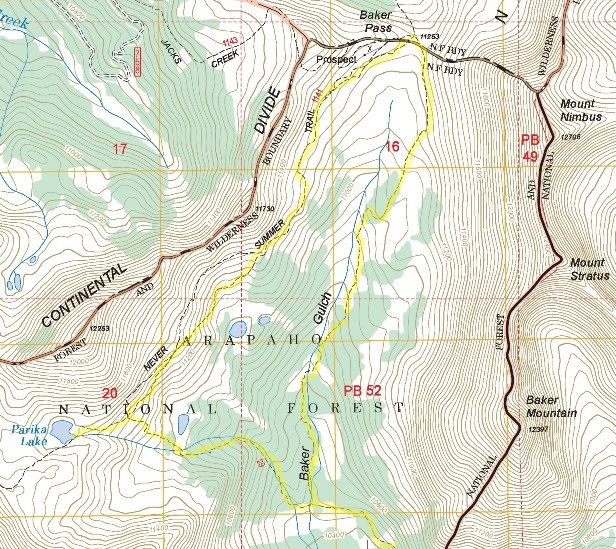
Over the course of the next mile-and-a-half the trail travels up Baker Gulch, while passing in and out of wooded areas. In some places the path is rather faint, and can be a little difficult to follow in some cases. This segment also travels over several boggy areas. Even in late-September our boots got a little muddy. During the early summer it's even worse, which could force hikers to move towards higher ground. If forced off the trail because it's too wet, or because you lost the trail, it's still fairly easy to find your own way towards the pass. This valley is fairly tight, with the stream on your left, and the steep mountain slopes on your right. Simply take the path of least resistance and proceed towards the north.
At roughly 5.5 miles the trail finally emerges from the canopy of the forest for the last time. From this point forward you'll enjoy spectacular views of alpine meadows and towering mountains. The trail continues for another hundred yards to reach the top of a rise before you're able to see Baker Pass, the low point on the saddle straight ahead. Rather than making a beeline for the pass from this spot, the trail skirts towards the right in order to move to higher ground. During this stretch the trail becomes a little faint in some areas, but cairns have been built to help guide the way.
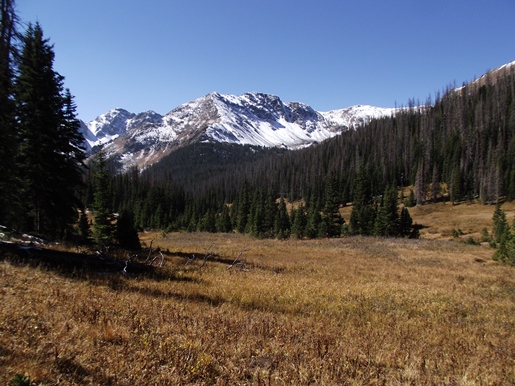
At just over 6 miles from the trailhead you'll finally reach the top of Baker Pass, which is marked by a national forest signpost. From this perch you'll enjoy spectacular 360-degree views. Towards the north, looking from left to right is Peak 12,098, Mt. Cirrus, Howard Mountain and 12,725-foot Mt. Cumulus, which dominates the view towards the northeast.
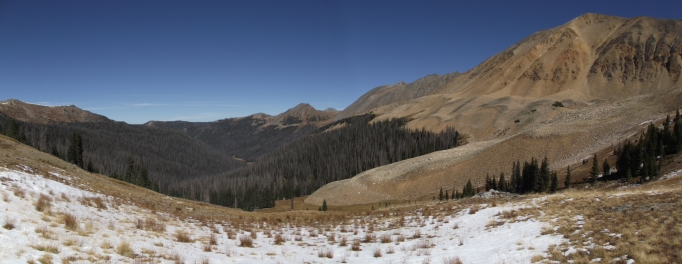
Looking towards the south, Mt. Nimbus, Mt. Strata and Baker Mountain form the wall along the east side of Baker Gulch. Further south, beyond the gulch, is Bowen Mountain, Peak 12,442, and Fairview Mountain. The Continental Divide forms the west flank above Baker Gulch. Peering just above the other side of the Divide is 12,394-foot Parika Peak.
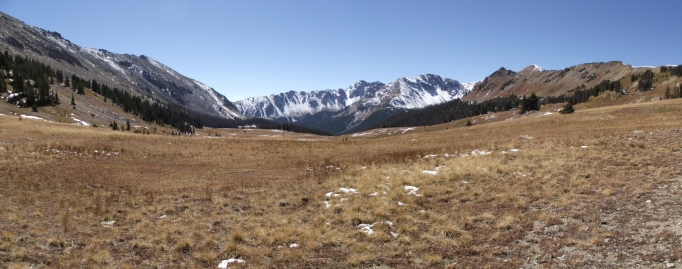
From Baker Pass the loop continues by traveling southwest towards Parika Lake. Look for a path that heads west and rises moderately uphill from the pass. Soon this path widens, and will appear to be an old wagon road along this stretch. According to the national forest map a footpath is supposed to branch off to the left here, but we never saw it. No problem, however, as we picked up the Baker Pass Trail further up the road. At just over 6.3 miles the old wagon road abruptly ends at a large mound of tailings from an old quartz mine. To continue forward, simply cross over to the far edge of the meadow (about 50 yards – see photo below) where you'll pick up the Baker Pass Trail after walking a few feet downslope. You may want to note that the national forest map above indicates that this trail is called the Never Summer Trail; however, it's referred to as the Baker Pass Trail on the wilderness kiosk and on several other websites. Additionally, the trail doesn't appear on the official national park map. It does, however, appear on the National Geographic Trails Illustrated Map.
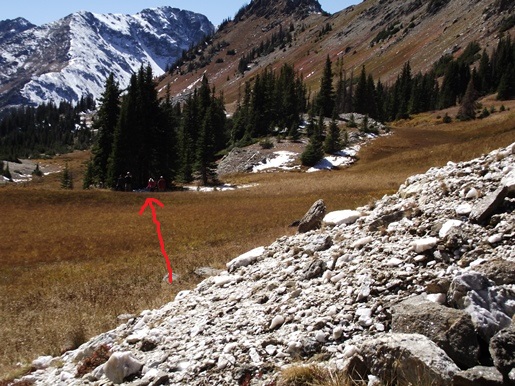
For the most part the Baker Pass Trail travels along a contour right at, or just above the treeline. Although there are a few ups and downs along the way, it mostly stays within an elevation range of roughly 11,250 feet and 11,350 feet. Although the trail is a little faint and a little rough in sections, it's fairly easy to follow. Early season hikers should also note that patches of snow can linger along this stretch until mid-July.
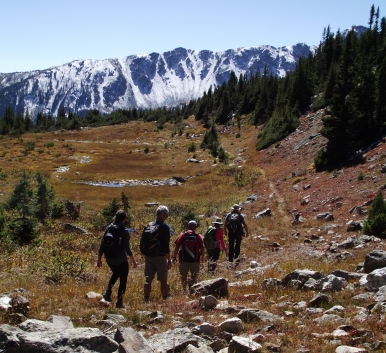 Hikers will enjoy outstanding views of Peak 12,442 and Fairview Mountain along much of this route. Just past the half-way point we saw several bighorn sheep cross over a ridgeline ahead of us. While sitting there watching them for several minutes, we saw two rams crash horns – a first for all of us in our group. Further along, as you approach the Parika Lake Trail junction, you'll also enjoy an outstanding view of Longs Peak in the far off distance towards the southeast.
Hikers will enjoy outstanding views of Peak 12,442 and Fairview Mountain along much of this route. Just past the half-way point we saw several bighorn sheep cross over a ridgeline ahead of us. While sitting there watching them for several minutes, we saw two rams crash horns – a first for all of us in our group. Further along, as you approach the Parika Lake Trail junction, you'll also enjoy an outstanding view of Longs Peak in the far off distance towards the southeast.
At roughly 8.1 miles hikers will reach the Parika Lake Trail. As of 2016 this junction was unmarked. To continue you should turn right here to make the short moderate climb up to the lake. After walking two-tenths of a mile you'll arrive at the eastern shore of Parika Lake.
This shallow alpine lake sits in a spectacular cirque basin surrounded by 12,246-foot Fairview Mountain towards the southwest, 12,394-foot Parika Peak towards the west, and Peak 12,253 towards the north, which is sometimes unofficially referred to as "Paprika Peak". The area surrounding this beautiful lake is also known for its spectacular wildflower displays after the winter snowpack melts.
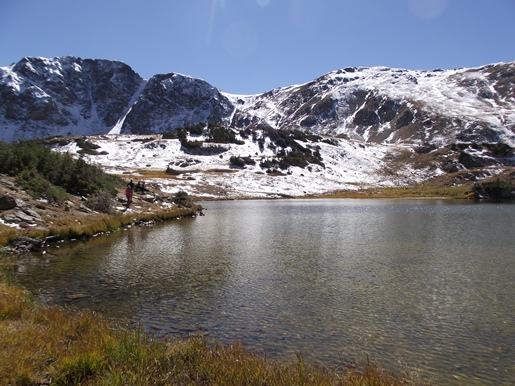
To continue the loop and return back to the trailhead, simply retrace your steps back down the Parika Lake Trail. After passing the Baker Pass Trail junction the trail makes a fairly rapid descent down towards the Baker Gulch Trail. Hikers will reach the Baker Gulch Trail junction at roughly 9.5 miles. To continue back to the trailhead proceed straight ahead from this junction and travel the remaining 4 miles back to the Bowen/Baker Trailhead.
Hikers should always be aware of lightning risk while hiking in the Rocky Mountains, especially at higher elevations. As a general rule of thumb you should plan to be off the higher elevations before noon in order to avoid the notorious afternoon thunderstorms that frequent the mountains during the summer months. Hikers should also be prepared for extreme sun exposure, wind, cool temperatures, and rapidly changing weather conditions while on the trail. Make sure you have the proper gear with you, and know what safety precautions you need to consider beforehand.
